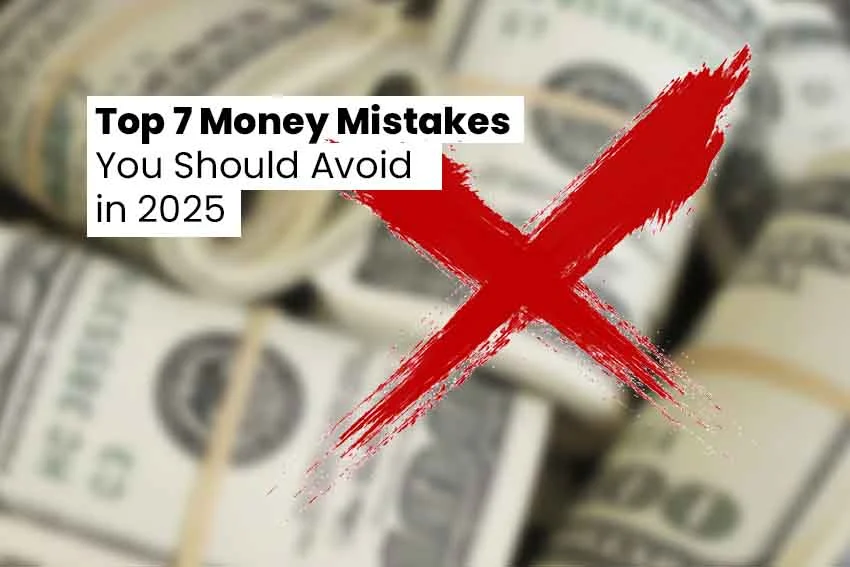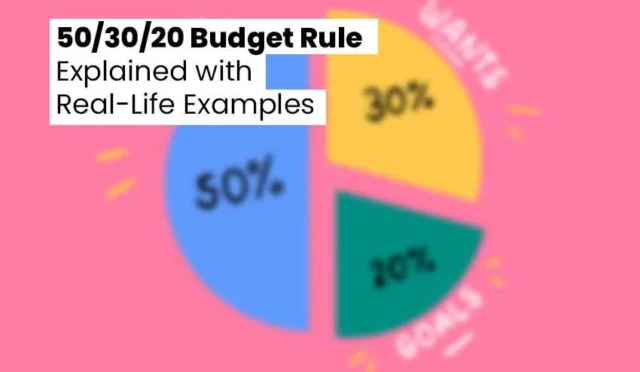If your paycheck keeps rising but your savings account looks stuck, the culprit is usually a handful of repeatable money mistakes. The good news: most money mistakes aren’t about willpower; they’re about system design. When you give your money a clear job and add a few guardrails, results show up quietly and consistently.
This guide breaks down the seven most expensive traps people fall into in 2025, why they happen, and what to do instead. You’ll get simple frameworks, short scripts you can use on the phone today, and a 30-day plan to reset your finances without living on rice and beans. By the end, you’ll know how to spot money mistakes before they start—and how to fix them fast when they do.
Contents
- 1 1) No Written Plan for Your Income
- 2 2) Lifestyle Creep After Every Raise
- 3 3) Carrying High-Interest Debt Without a Strategy
- 4 4) Ignoring Risk: No Emergency Fund or Insurance Review
- 5 5) Investing Randomly (or Not at All)
- 6 6) Letting Subscriptions and Small Leaks Run the Show
- 7 7) No System for Big Purchases (Cars, Phones, Travel, Furniture)
- 8 A 30-Day Reset Plan for 2025
- 9 The Right Tools for a Calm Money System
- 10 Metrics That Matter (and Those That Don’t)
- 11 Frequently Asked Questions
- 12 Your Next Three Moves
1) No Written Plan for Your Income
Winging it is comfortable until a surprise bill arrives. Without a written plan, you under-save, forget annual expenses, and rely on credit to bridge gaps—textbook money mistakes.
What to do instead
- Choose a framework you’ll actually maintain: 50/30/20, zero-based, or a simple pay-yourself-first.
- Open two checking accounts—Bills and Spending—plus a separate Savings account.
- Automate payday transfers in this order: Savings → Bills → Spending.
- Add sinking funds for predictable “surprises”: car maintenance, annual premiums, travel, gifts.
15-minute setup
- List fixed bills and due dates.
- Sum annual/irregular costs and divide by 12 to set monthly transfers.
- Rename accounts in your app so the purpose is obvious.
- Turn on notifications for low balances and large transactions.
Put this in place and you’ll erase one of the most common money mistakes by next payday.
2) Lifestyle Creep After Every Raise
If every raise becomes a subscription, upgrade, or bigger car payment, you’ll feel broke at any income. It’s one of those quiet money mistakes that compounds in the background.
The 50% rule for raises
For the next 12 months, direct 50% of every raise, bonus, or overtime to the “future” bucket (debt payoff, emergency fund, investing). Enjoy the remaining 50% guilt-free.
Micro-systems that help
- The week your raise hits, increase retirement or brokerage contributions automatically.
- When a promo ends (internet/phone), keep paying the old amount and redirect the difference to savings.
- Use a “First Friday” calendar reminder to review subscriptions and cancel one you don’t use.
Break lifestyle creep once and you’ll dodge one of adulthood’s most expensive money mistakes.
3) Carrying High-Interest Debt Without a Strategy
Interest north of 20% turns balances into permanent roommates. Random extra payments aren’t a plan; they’re hope—and hope is how money mistakes multiply.
A practical payoff plan
- Build a $500–$1,000 starter emergency fund so surprises don’t go on the card.
- Pick a method and stick with it:
- Avalanche: highest APR first (mathematically fastest).
- Snowball: smallest balance first (fastest momentum).
- Automate an extra payment the day after payday.
- Consider consolidation only if the new APR is genuinely lower and fees are minimal.
Progress you can see
- Write your debt-free date on the calendar.
- Every time you finish a balance, roll that payment to the next—momentum matters.
Targeted execution prevents this class of money mistakes from draining both cash and confidence.
4) Ignoring Risk: No Emergency Fund or Insurance Review
Skipping an emergency fund is like driving uninsured: fine until the day it isn’t. Turning predictable bumps into credit-card crises is one of the costliest money mistakes.
Build layers, not perfection
- Stage 1: $1,000 buffer in 30–60 days.
- Stage 2: 1 month of expenses within 90 days.
- Stage 3: 3–6 months once high-interest debt is under control.
Annual protection audit
- Health: know your deductible and out-of-pocket max.
- Auto/home/renter’s: get quotes; raise deductibles only if your fund can handle it.
- Life: level-term if anyone relies on your income.
- Disability: protects the paycheck that funds everything else.
A calm buffer turns bad days into manageable ones—and keeps you out of spiral-inducing money mistakes.
5) Investing Randomly (or Not at All)
Waiting for “the right time” is market timing with better PR. Another frequent money mistakes cluster: letting cash idle while inflation works against you, or chasing hype without a plan.
Automate a boring, effective strategy
- Choose a simple target allocation:
- 70–90% broadly diversified stock index funds/ETFs.
- 10–30% in stabilizers you understand (bonds, cash-like holdings) or a small, rules-based tilt.
- Automate contributions on payday (retirement and, if appropriate, a taxable account).
- Rebalance once or twice a year, not weekly.
- Write guardrails: “No single stock over 5%,” “No FOMO buys,” “No touching the emergency fund.”
Quick wins
- Capture any employer match—it’s instant return.
- Name accounts (“Home Fund,” “Freedom Fund”) so every dollar has purpose.
Avoiding these money mistakes lets compounding quietly work while you live your life.
6) Letting Subscriptions and Small Leaks Run the Show
It’s not the latte; it’s unused software, overlapping services, and forgotten trials. Small leaks are sneaky money mistakes that absorb entire raises.
The three-bucket audit
- Keep: essential or heavy-use items.
- Maybe: set a 30-day reminder; keep only if used.
- Cancel/Downgrade: today.
Proven scripts
- Internet/mobile: “I like the service, but the price is high. Are there loyalty or retention offers?”
- Insurance: “I’m comparing quotes. Can you match X or add a discount?”
- Software: “I don’t need premium features. Can we switch to annual discount or pause for 3 months?”
Then set a weekly spending cap in your Spending account. The balance becomes your feedback loop and prevents recurring money mistakes.
7) No System for Big Purchases (Cars, Phones, Travel, Furniture)
Most “emergencies” are predictable: phones die, tires wear, friends announce destination weddings. Financing these at credit-card rates is one of the most avoidable money mistakes.
Build a pre-decided plan
- Create the Big Four sinking funds: Tech, Car, Home/Move, Travel/Gifts.
- Pick target amounts and monthly contributions.
- Use a 72-hour rule for any purchase over your threshold (e.g., $300).
- For cars: buy used, keep total cost under 10–15% of gross income, and hold 8–10 years if reliable.
Pre-decisions keep you out of the panic zone where money mistakes thrive.

A 30-Day Reset Plan for 2025
You don’t need a perfect year—just a strong month. This sprint removes the most expensive money mistakes and installs automation.
Week 1: Map and Automate
- Pick your framework (50/30/20, zero-based, or pay-yourself-first).
- Create Bills / Spending / Savings accounts and rename them.
- Schedule transfers on payday; start a $500 buffer.
Week 2: Debt Momentum
- Choose avalanche or snowball; automate an extra payment.
- Call two providers to negotiate; redirect savings to your payoff plan.
- Freeze one card if it’s your weak spot.
Week 3: Invest and Protect
- Turn on automatic contributions (retirement + brokerage).
- Do a 60-minute insurance review.
- Document your rebalancing rule and schedule it.
Week 4: Leaks and Big Purchases
- Cancel or downgrade three subscriptions.
- Set up the Big Four sinking funds and fund the first month.
- Add a 72-hour reminder automation for purchases over your threshold.
By day 30, you’ve erased the highest-impact money mistakes, and your system runs even on busy weeks.
The Right Tools for a Calm Money System
Accounts and automations
- One login per bank, strong passwords, and 2FA.
- Automatic transfers, bill pay, and contribution schedules.
Tracking without obsession
- A single monthly “Money Hour” to review trends.
- A simple dashboard: savings rate, debt-free date, net-worth trend.
Friction reducers
- Canned negotiation scripts in your notes app.
- A spending cap notification for weekend splurges.
- Email filters for receipts and bills so nothing gets lost.
The best system is the one you’ll keep. Complexity invites money mistakes; simplicity prevents them.
Metrics That Matter (and Those That Don’t)
Watch monthly
- Savings rate (% of take-home that goes to future you).
- Debt-free date projection.
- Three-month average spending vs. plan.
- Net-worth trend (quarterly is fine).
Ignore
- Daily stock moves and clickbait predictions.
- Other people’s highlight reels.
- One-off “hacks” that complicate your routine.
Focusing on signal over noise keeps you out of reaction mode, where money mistakes are born.
Frequently Asked Questions
Do I need a strict budget to avoid money mistakes?
No. You need a simple, automated plan: pay your future self first, give bills their own account, and let the spending account be your buffer. That setup alone removes several money mistakes.
How big should my emergency fund be?
Start with $500–$1,000, then one month of expenses, then 3–6 months once high-interest debt is under control. This sequence prevents cascading money mistakes when life happens.
I’m late to investing. Is it worth starting now?
Yes. Automate contributions to diversified funds, ignore daily noise, and rebalance on a schedule. Procrastination is one of the quietest money mistakes; starting small beats waiting.
Are subscriptions really a big deal?
Not individually—collectively. Canceling three unused services can fund your emergency buffer or accelerate debt payoff. Left unchecked, they’re slow-motion money mistakes.
Can I pursue multiple goals at once?
Yes, but sequence matters: stabilize cash flow → build a buffer → attack high-interest debt → automate investing. Clear order prevents competing priorities from turning into money mistakes.
Your Next Three Moves
- Rename your accounts to Bills / Spending / Savings and set payday automations.
- Pick avalanche or snowball and schedule one extra payment.
- Create the Big Four sinking funds and start with $25–$50 each.
Take these steps today and you’ll avoid the most common money mistakes this year and every year after. You don’t need a new personality to get ahead—you need a system that quietly does the right thing on your behalf. Keep it boring, keep it automatic, and let your progress compound.
Ready to take the next step? Dive into our Money Management guides for practical budgeting tips, debt payoff strategies, and smarter saving habits — so your money works the way you want:
Explore the Money Management category →




